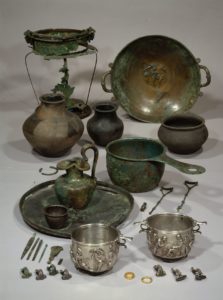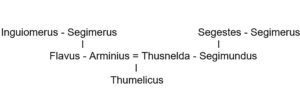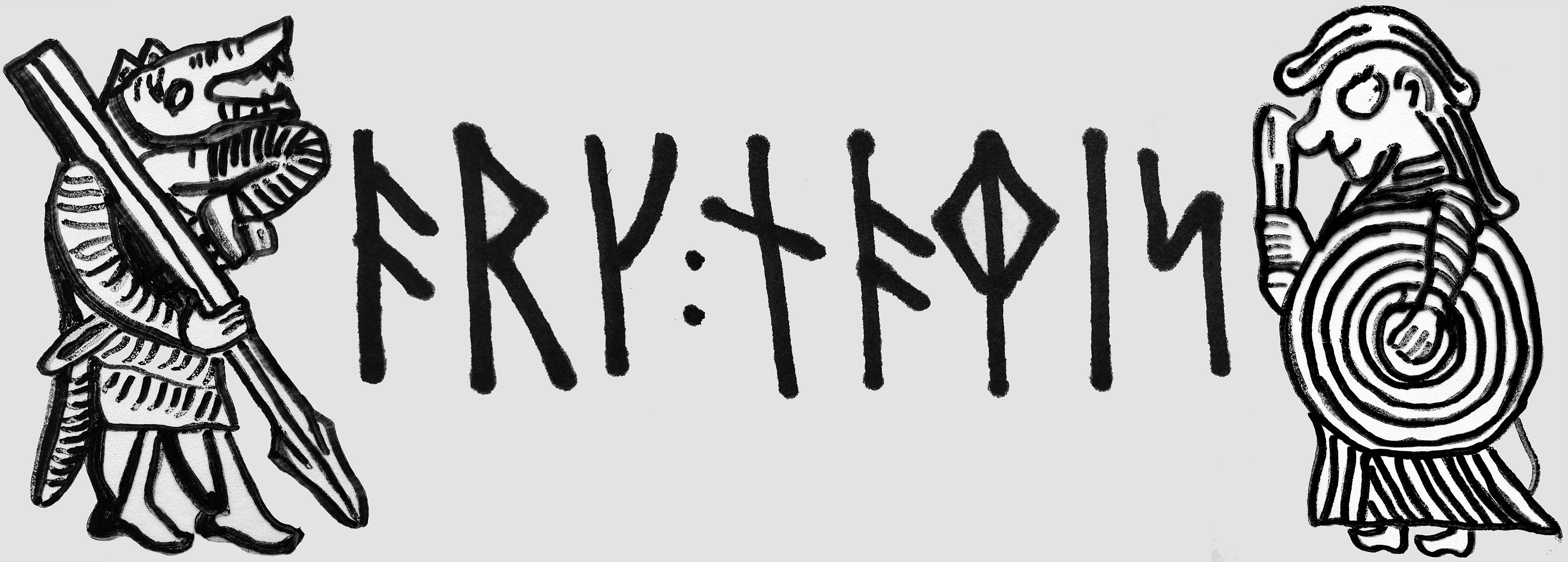Name use in the Netflix series and in early Germanic tribes
The 2020 Netflix series Barbaren or Barbarians, retells the famous story of Arminius, a Roman-raised Germanic prince, who led a conglomerate of Germanic tribes to victory over three Roman legions in the Teutoburg forest in the year 9 AD. A historical turning point and a fascinating chain of events which we know about from several Roman sources. In recent decades, archaeological evidence has even emerged in Northern Germany that could be related to the battle.
I generally really enjoyed the Barbarians very much and found that the creators had payed attention to both historical and archaeological evidence, with for example, the German Historical production company Kaptorga in charge of the weaponry. Still, as the makers of the series have stated, they were first of all making entertainment and further were careful angling the story because the Teutoburg Forest event has been used politically by German Nationalists through the last three centuries.
Of course, the historical accuracy of the series has been discussed a lot. Archaeologists often enjoy criticizing and finding faults when the entertainment industry takes on subjects that are almost impossible to portray accurately. Watching the Barbarians, I kept asking myself whether I found that the tribes were depicted as too primitive (complying with the Roman ways of describing them) or whether they were “not strange enough” and too easy for us to identify with as modern spectators. Nevertheless, if we look beyond the details, renderings such as this series manage to bring life to historical situations in unique ways. The Barbarians series does use some poetic license: for example it portrays Arminius as the adoptive son of the governor Varus. This is not a historical fact, although Arminius was raised in Rome, but it serves to illustrate the personal and cultural conflicts he would have faced when choosing to turn against the Romans.
The empire and the tribes
I particularly think the creators succeeded in illustrating the great technological and organisational differences between the Germanic tribes and the Romans. In the first scene we see a boy, Ansgar, running through a village passing iron extraction furnaces, a wool-dying shed, racks with drying skins and meat and small plots for cereal crops (although these were a bit smaller that the fields we know of from archaeology). The village consists of small thatched three-aisled longhouses and we even see a fireplace aligned with decorated clay blocks (but why are doors in these kinds of films always just some sticks nailed to a beam with huge gaps in between?). The Germanic inhabitants are clad in the types of woolen garments we know from bog finds and furs of sheep and wolf. Then, the Roman army comes calling in shining sets of armor, helmets with feathers, tiger skins etc. to demand more taxes.
We also quickly get a good impression of the relationship between the various tribes: many small groups in many ways interrelated, but also disagreeing politically, warring with each other – some teaming up with Rome and some fighting Rome. Researchers estimate that there were around 50 of such tribal units in the North Germanic area at this point in time.

The shaky ground
The description of the Germanic religion is one of the hardest parts and these were also the scenes where I flinched the most. The few passages from Roman sources, especially Tacitus, about the beliefs and ritual practices of the Germanic peoples, have been scrutinized carefully by hundreds of researchers. Of course we have archaeological evidence – but we still understand very little of these religions. However, features such as the sacrificial bog and the way the reiks (chieftain), Segimer, sacrifices himself in it, fit well with some of the knowledge we have. There is also evidence for female ritual specialists, but they probably wore white robes rather than dark fantasy outfits (the priestess here reminded me of the shaman in the HBO Vikings series).
The Barbarians series then fills the gaps with later material. The myths the characters tell are taken from Old Norse mythology and the main gods are Wotan and Donar, only known from much later sources. The Roman writers translated the Germanic pantheon into their own names for deities and some researchers believe that these two are equivalent with Mercury and Hercules mentioned by e.g. Tacitus. See a good and up to date discussion of this in Jens Peter Schødt’s article here.
Names and early Germanic language, families and tribes
With my basic knowledge of Latin, I especially enjoyed the Roman dialogue in the Barbarians being carried out in this language with classical Latin pronunciation. Unfortunately, we know so little about the Germanic languages of that time, so the actors spoke modern German although they incorporated words like the term reiks (Proto Germanic *rikaz) related to Celtic rix and Latin rex and used in Gothic for a chieftain or tribe leader. This word is also used as a last name element in both Celtic and Germanic (such as Vercingetorix, Theoderic, Eirik (see a blog post about this element here). In fact, the very earliest evidence we have of Germanic language is almost completely limited to names. The name Harigasti (warrior/war-host+guest) written on the 1 c. BC Negau helmet is probably the first attested Germanic word.
We also know Germanic names from Roman sources before the Runic script appears, and here, Arminius and the people around him are particularly interesting, because this group serves as one of our first and most detailed examples of the traditional Germanic naming system. For those interested in delving deeper into this topic, I recommend the paper by Thorsten Meissner in this collection.
In the Germanic naming system, elements from parents’ names (mostly the father or grandfather, but maybe also the mother or other family members) were recombined with other elements in new names and seemingly some families preferred certain elements. Another trait was the use of alliterations to emphasise kinship connections. This naming behaviour meant that names not merely worked as labels, but placed the name bearer within a system of family, tribal and social connections. This naming system was deeply embedded in Germanic ruling families from the 1st to the 11th centuries. Elites in Germanic society favored transferring of an element from a parent and alliteration with siblings or parents while non-noble Germanics, who had become Roman citizens, did not follow these practices.

In Arminius’ family tree, we see that his father and uncle are named according to the Germanic tradition, having the second element –marr, latinised –merus, ‘famous’. We also see how the first element seg-, ‘victory’ is quite popular in the families of both Arminius and Thusnelda. Thusnelda had a brother, Segimundus (victory + guardian/protector) who served in the imperial cult in Trier, but joined the rebellion. You will recognize some of these names in their later and modern forms: Ingmar, Sigmar and Sigmund.
Thusnelda’s name is difficult to interpret, but it can be noticed that the name of their son alliterates with her name rather than Arminius’.
In this framework, it is clear how the names of Arminius and his brother Flavus break with the traditional Germanic way of communicating social identity. It is not known exactly what the name Arminius is derived from. It is either Roman or a latinised Germanic name and seems unrelated to his family tradition. The brother Flavus has an entirely Roman name. Flavus means ‘blonde’ and was a common Roman personal name or nickname. So it is likely that both brothers were renamed or chose to change their names when they were brought up in Rome.
The Barbarians generally follow the naming of known historical figures, but when it comes to the fictive characters, they could sometimes have made better choices. The name Folkwin (people/crowd+friend) is known in the 9th century AD. However, in the 1st century, the pronunciation would probably have been *Fulkawiniz. In the series, Thusnelda has a smaller brother, Ansgar who has been given an anachronistic name form, known from much later sources. At this early point in time, his name would have been *Ansugaizaz (god+spear). Also Berulf (bear+wolf) would rather have been *Berawulfaz. We also meet an Eigil, a name that appears in Icelandic sagas more than 1000 years later.
As with the religion, the series here tends to fill in the gaps with later material – but when it comes to names, we have a large gallery to choose from in both Roman sources, epitaphs and Early Runic inscriptions, that the series could have made more use of.
